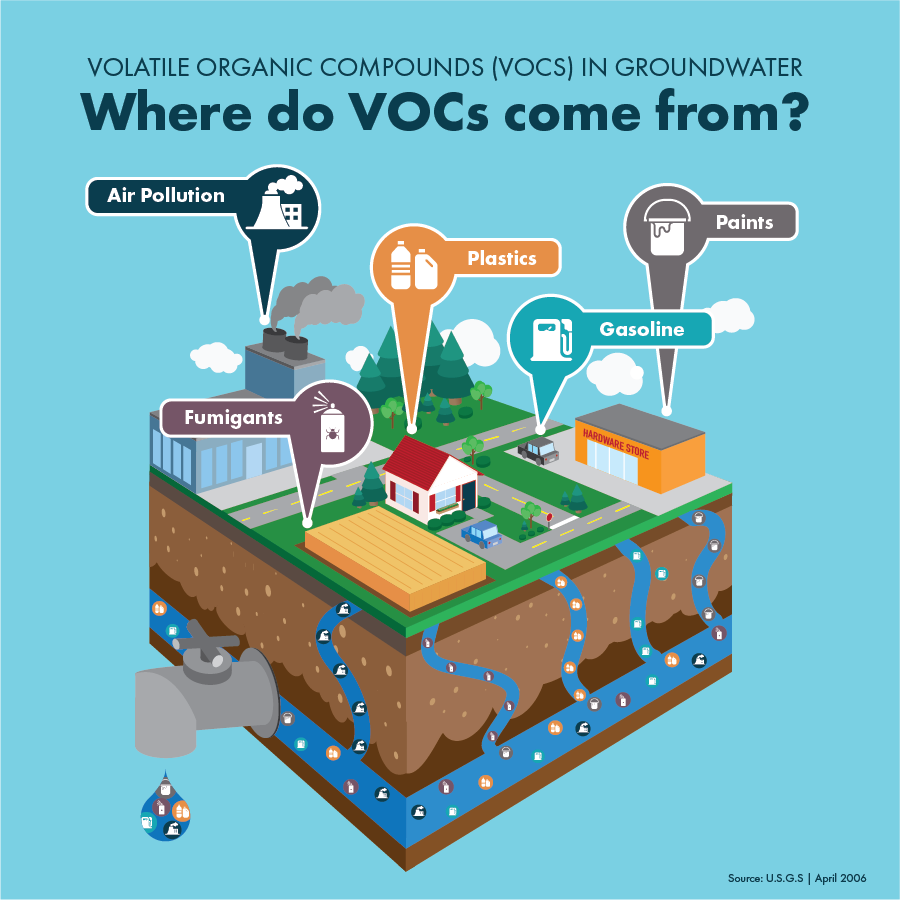Do Volatile Organic Compounds (VOCs) Impact Drinking Water?
VOCs are a mixture of elements which turn into gases. They come from burning gasoline, coal, wood or natural gas. And could be in your groundwater.
Posted in
Culligan Nation,
Culligan Solutions,
Drinking Water,
Drinking Water System,
Home & Health,
Reverse Osmosis,
Tap Water,
Water Filtration System,
Water Problems

What are volatile organic compounds (VOCs)?
VOCs are a mixture of elements which easily turn into vapors or gases. These mixtures release from burning fuels like wood, gasoline, natural gas or coal. And they live in consumer products like cigarettes, paints, preservatives, disinfects, air fresheners and more.
In fact, they are found in all of these products:
- Pesticides
- Copy machines
- Printers
- Air Fresheners
- Building materials and furnishings
- Cleaners and disinfectants
- Moth repellents
- Glues
- Wood preservatives
- Dry-cleaning fluids
- Adhesives
- Paints and paint thinners
- Solvents
- Cigarettes

How can you be exposed to VOCs?
Because VOCs are released through common, everyday items, exposure to them can be high.
First, exposure can enter the body through the air. Breathing in gases or fuels containing VOCs is the most common route. Additional inhalation occurs through car exhaust, trucks, trains and other vehicles. As well as from cigarettes and secondhand smoke.
Exposure through skin contact is the second most likely. For example, anytime skin comes into contact with paints, cleaners, disinfectants or glues harmful compounds can be consumed.
Although some VOCs are easy to see, like smoke and gas exhaust, some are more difficult to detect. For instance, an air freshener might spray out of a can and make the room smell better. But once the chemicals are absorbed into the air, it might be impossible to see the compounds remaining.
Are volatile organic compounds found in drinking water?
A study by the U.S. Geological Survey shows the occurrence of VOCs in groundwater and well water. However, of the water tested, many aquifers and wells measured below 0.2 parts per billion. And that meets the federal drinking water standards.
But specific compounds appear in water supplies more than others.
Chloroform and other THMs (trihalomethanes)
Chloroform is the most common VOC, according to the study. And it was collected in 7 percent of samples out of 98. Because chloroform is a common ingredient in many household items, it is more readily available.
Common uses for chloroform include:
- Refrigerants for home air conditioners
- Commercial (and large) freezers
- Reagents
- Extraction Solvents
- Fumigants
- Insecticides and pesticides
- Dyes
In addition, bleaching and chlorinating water contribute to the production of VOCs. So while chlorine and bleach are disinfecting agents, they can also create VOCs in the process of disinfecting. And those VOCs could be lingering in your water.
MTBE (methyl tertiary-butyl ether)
MTBE is a colorless, flammable liquid. And its primary use is to increase the oxygen content in gasoline. Adding MTBE to gasoline can reduce harmful emissions by increasing oxygen and improving combustion.
Unlike chloroform and other common THMs, MTBE is found in concentrated areas. So MTBE detection is higher in places with a lot of people.
PCE (perchloroethylene) and TCE (trichloroethylene)
PCE's are chlorinated solvents. Similar to industrial uses, commercial and domestic applications also use PCEs. For example, more than 80 percent of commercial dry cleaners use PCE as a solvent. Because solvents have high densities, and high solubility, they move easily in groundwater.
PCE is also a parent compound to TCE. In other words, TCE forms as a result of biodegradation of PCE. TCE does not naturally occur in the environment. Therefore, it is manufactured and stored inorganically.
Common uses of these two compounds include disinfectants, dyes, perfumes, pharmaceuticals and soaps.
Are VOCs dangerous?
Although VOCs are present and could cause harm to the general population, the most at risk people include those with asthma, children and elderly individuals.
Short-term exposure to VOCs may cause:
- Memory problems
- Headaches
- Dizziness
- Visual disorders
- Irritation of the eyes
- Irritation of the respiratory tract
Long-term exposure to VOCs may cause:
- Cancer
- Dizziness
- Nausea
- Loss of coordination
- Fatigue
- Damage to liver, kidneys and central nervous system
- Irritation of the eyes
- Irritation of the nose and throat
Pesticides
Pesticides cover a large group of compounds making up VOCs. To clarify, pesticides are compounds that destroy, repel, prevent or reduce pests. And different pesticides have different toxicity levels.
Some common pesticides include:
- Rodenticides to remove mice and other rodents.
- Insecticides to eliminate insects.
- Herbicides to kill weeds.
- Algicides to manage algae.
- Fungicides to reduce fungi.
- Antifouling agents which kill organisms living in water and on boats.
Exposure to pesticides can cause:
- Nervous system damage
- Cancer
- Hormone and endocrine system damage
- Birth defects
Solvents
Because solvents are liquid or gas, they dissolve easily with other substances. Solvents are commonly found in consumer products. For example, household cleaners, nail polish remover, glue, paint, pesticides, grease and oil.
Short-term exposure can cause:
- Seizures
- Unconsciousness
- Nausea
- Vomiting
- Headaches
- Difficulty breathing
- Irritated eyes, nose or throat
- Memory loss
- Dizziness
Long-term exposure can cause:
- Cancer
- Blindness
- Leukemia
- Irregular heartbeat
- Reproductive harm
- Impact on cognitive function
Extreme levels of solvents can cause severe problems. Like skin burns, rashes or even death.
Culligan Solutions
Culligan offers a wide variety of treatment solutions for water contaminated with VOCs. One solution is Reverse Osmosis (RO).
Reverse Osmosis Filtration
When thinking about the RO Filtration process, it's helpful to break it down into four specific steps.
In general, all reverse osmosis systems have pre-filtration, reverse osmosis, drainage and storage stages.
Let's explore what that means.
First, pressurized water moves through a particle filter. This removes impurities like salt, sand and sediment.
Next, the water passes through an activated carbon filter. Which traps and removes minerals and contaminants such as chlorine, mercury, copper and pesticides. These are considered part of the pre-filtration stage.
After that, pressurized water forces its way through the semipermeable membrane. So that the smallest impurities become trapped and only water passes through. This is the reverse osmosis stage.
Finally, the discharge stage. In this stage, removed contaminants get flushed away. While the treated water moves to a storage tank.
Before the treated water reaches a faucet, it undergoes a final activated-carbon filtration. Therefore improving the taste and quality for household use.
What Contaminants Does Reverse Osmosis Reduce*?
RO Filtration can significantly reduce some of the most dangerous impurities. So what does reverse osmosis actually reduce?
Lead
There is no safe level of lead exposure, especially for children. And this contaminant cannot be seen, smelled or tasted. So the only way to know whether lead is in your water is to test for it.
Mercury
Burning fossil fuels, as well other human activities, produce mercury. Additionally, it can be found in drinking water as a result of the natural degassing of the earth's crust. Too much mercury in the body damages the brain and kidneys, or even a developing fetus.
Chromium-6
Chromium-6 is also called hexavalent chromium. And it's an industrial chemical found in the drinking water of all 50 states. Chromium-6 is a known carcinogen, linked to cancer, reproductive issues, asthma attacks and other severe side effects.
Chlorine
While the aesthetics of chlorine are not necessarily health-related, they affect the taste and odor of your water. If you don't want your water tasting or smelling like chlorine, an RO can take care of that.
Chloramine
Chloramines are a derivative of ammonia and contribute to an altered taste or smell in your drinking water.
Sediment
Cloudiness or haziness in water can be caused by high sediment levels. The higher the sediment level in drinking water, the greater chance consumers have of developing gastrointestinal diseases.
Over 90 Additional Contaminants
A Culligan Reverse Osmosis drinking water system is certified to reduce every EPA-regulated contaminants. More than 100 in total. In comparison to other popular at-home filtration methods, its power is second to none.
In Conclusion
Consumer products, household cleaning supplies and automobiles all contribute to VOCs in the environment. Which can eventually lead to VOCs in drinking water.
*CONTAMINANTS MAY NOT BE IN YOUR WATER. CULLIGAN REVERSE OSMOSIS SYSTEMS CAN REDUCE CONTAMINANTS BY UP TO 99.9%
